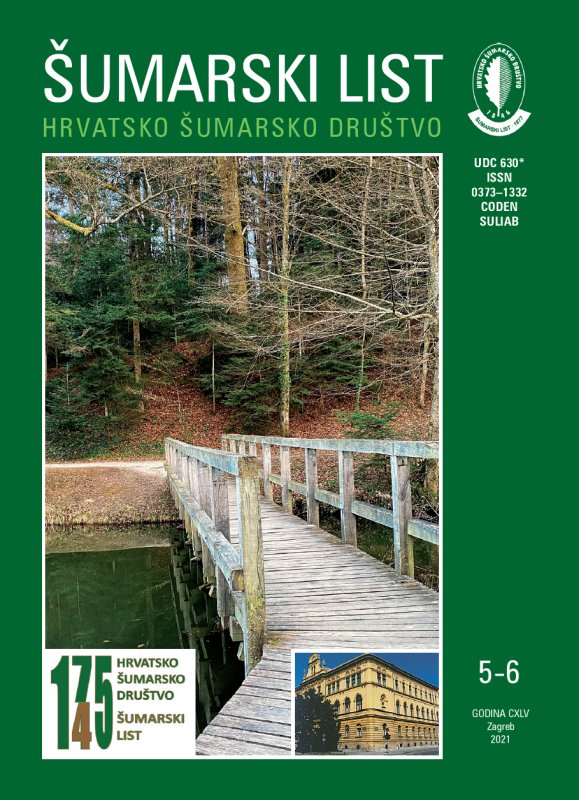
broj: 5-6/2021
pdf (15,7 MB) |
|
||||||||||||||
| RIJEČ UREDNIŠTVA | ||
| Uredništvo | ||
| The demise of a man who has devoted his life to forests and forestry pdf HR EN | 209 | |
| IZVORNI ZNANSTVENI ČLANCI | ||
| Tomislav Poršinsky, Vitomir Kajgana, Željko Tomašić, Andreja Đuka | UDK 630* 453 (001) https://doi.org/10.31298/sl.145.5-6.1 | |
| Gradeability of the cable skidder based on traction performance pdf HR EN | 211 | |
| Krunoslav Sever, Dimitrije Damir Sviličić, Tomislav Karažija, Boris Lazarević, Željko Škvorc | UDK 630*232.3 (001) https://doi.org/10.31298/sl.145.5-6.2 | |
| Photosynthetic response of common beech seedlings to suboptimal mineral nutrition pdf HR EN | 225 | |
| Ahmet Lojo, Jusuf Musić, Besim Balić, Admir Avdagić, Velid Halilović, Aida Ibrahimspahić, Jelena Knežević | UDK 630* 523 (001) https://doi.org/10.31298/sl.145.5-6.3 | |
| Modeling bark thickness of beech (Fagus sylvatica L.) pdf HR EN | 239 | |
| Tark Çtgez, Refik Karagül, Mehmet Özcan | UDK 630*114.1 + 116 https://doi.org/10.31298/sl.145.5-6.4 | |
| Evaluation of the effects of some watershed characteristics on water and suspended sediment yield in agricultural and forest dominated watersheds pdf HR EN | 249 | |
| Summary Topography, geological structure and land use play a determinative role in the streamflow and total suspended sediment yield of watersheds having similar climate, soil and vegetation characteristics. In order to facilitate sustainable water resource management and effective land use planning, there is an increasing need for research investigating the effects of these factors. This study was carried out in forested and agricultural dominated subwatersheds of the Big Melen watershed in the Western Black Sea Region of Turkey. Hazelnut plantations are grown on most of the agricultural areas in both watersheds. The forested watershed has a steep topography and its geological structure consists of sandstone-mudstone and sedimentary rock. The agricultural watershed area is larger and unlike the forested watershed, there is argillaceous limestone in its geological structure. The precipitation, streamflow and total suspended sediment yield in the watersheds were measured for two years. The total precipitation of the study area over the two years was 2217.3 mm. The water yield of the forested watershed was 867.6 mm, while that of the agricultural watershed was 654.9 mm. In the two years, the total suspended sediment transported from the forested watershed was 19.51 t ha-1 and from the agricultural watershed 7.70 t ha-1. However, except for the high values measured after an extreme rainfall event, the unit surface suspended sediment yield of the agricultural watershed was found to be higher than that of the forested watershed. These findings showed that watershed characteristics such as slope, geological structure and rainfall intensity may be more effective on the streamflow and total suspended sediment yield of the watersheds than land use. Key words: Big Melen watershed; land use; suspended sediment yield; watershed characteristics; water yield | ||
| PRETHODNO PRIOPĆENJE | ||
| Nediljko Landeka, Mirela Uzelac, Danijela Poljuha, Barbara Sladonja | UDK 630* 453 https://doi.org/10.31298/sl.145.5-6.5 | |
| The first record of the asiatic string cottony scale Takahashia japonica in Croatia pdf HR EN | 263 | |
| Toni Safner, Ana Gracanin, Ivan Gligora, Boštjan Pokorny, Katarina Flajšman, Marco Apollonio, Nikica Šprem | UDK 630* 461 https://doi.org/10.31298/sl.145.5-6.6 | |
| State border fences as a threat to habitat connectivity: a case study from South-Eastern Europe pdf HR EN | 269 | |
| PREGLEDNI ČLANCI | ||
| Marina Milović, Marko Kebert, Saša Orlović | UDK 630* 172.8 https://doi.org/10.31298/sl.145.5-6.7 | |
| How mycorrhizas can help forests to cope with ongoing climate change? pdf HR EN | 279 | |


